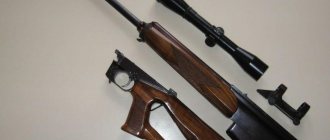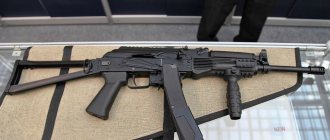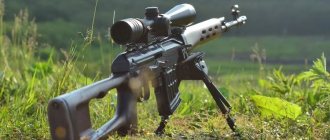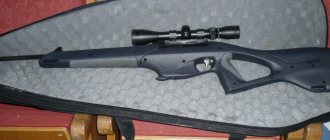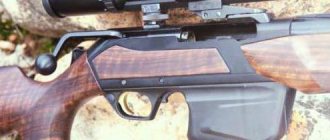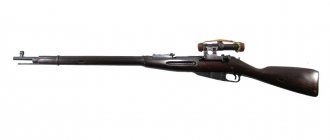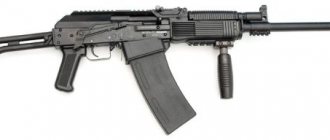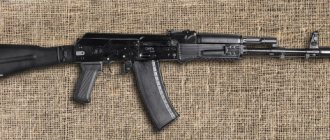On February 10, 2015, the outstanding designer - gunsmith, a wonderful person, an employee of the branch of OJSC KBP - TsKIB SOO, who devoted his entire career to sports and hunting weapons - Tula gunsmith Viktor Nikolaevich Denisov .
The multifaceted designer’s more than half-century career is marked by outstanding achievements in the creation of various types of weapons that are not inferior in their characteristics to the best foreign and domestic models, and in many cases superior to them.
The beginning of the journey of a master gunsmith
The beginning of the creative path of gunsmith Viktor Nikolaevich was joining the Central Design Bureau of Sports and Hunting Weapons (TsKIB SOO) immediately after graduating from the Tula Polytechnic Institute. Viktor Nikolaevich remained faithful to his native enterprise during 55 years of work.
It is necessary to pay special attention to the fact that the direction of work activity chosen by Viktor Nikolaevich was determined in his early youth, by his origin and environment.
When Victor was born in 1935, his father Denisov Nikolai Kondratyevich and mother Denisova (Sidorova) Maria Dmitrievna, hereditary peasants, lived in Tula.
The Denisov and Sidorov family are peasants and hereditary gunsmiths, followers of Russian nuggets, peasant gunsmiths, who, by the decrees of the Rulers of Russia in the 16th - 17th centuries, were allowed to engage in the arms business.
His maternal grandfather, Sidorov Dmitry Vasilyevich, originally from peasants, in the 19th century with his relatives was involved in the weapons of the Tula Arms Factory - they assembled hunting weapons from factory parts.
D.V. Sidorov continued assembling weapons during the NEP. He took a direct part in the assembly of 12-gauge hunting shotguns, converted from Berdan rifles (model “K”), single-barreled Frolov rifles and samples of D. M. Kochetov (model “R”).
It is necessary to pay attention to the fact that TOZ in the 20s of the 20th century continued the tradition of the end of the 16th century - attracting peasants from the Tula region to carry out work on the manufacture of weapons from nearby villages. Entire villages were engaged in this trade and they had quite significant earnings. In particular, D.V. Sidorov lived in the village of Maryino near the village of Shatsk, Tula region. The family consisted of 6 people: himself, his wife, two sons and two daughters. They lived well: they had land, a house, a horse and a cow. The assembly of guns was carried out in a small workshop at the house. The family was a working family: they were engaged in agriculture in the summer, and assembling weapons mainly in the autumn-winter season and, as far as possible, during agricultural work.
Such work continued in Soviet times under the NEP until the state nationalized weapons production.
During the Great Patriotic War, men went to defend their Motherland: Dmitry Vasilyevich’s son, as well as Viktor Nikolaevich’s father, Nikolai Konstantinovich, laid down their heads on the battlefield, and Dmitry Vasilyevich replaced Victor’s father and he also passed on to the boy Vita a love of metal and weapons.
During the hard times of war, Victor’s further acquaintance with weapons continued. The family then lived on Galkin Street and the guys ran behind the railway track, where the captured weapons were stored. The security was terrible and the boys chose their weapons “to suit their taste”, then polished them until they shined, and then played war: “they beat the fascists!”
We came across weapons that were functional and even came with cartridges, and it’s good that these “combat campaigns” ended successfully.
The “raids” on the railway station later determined the future fate of Viktor Nikolaevich Denisov.
There was youth ahead. After finishing the seven-year school, he entered the technical school named after. S.I. Mosina. And then chance helped, he ended up in a group where he met good guys who were passionate about weapons technology, and he took his studies seriously.
Technical College named after S.I. Mosin in Tula.
A mathematics teacher and student group curator, Dmitry Pavlovich Budaev, had a great influence on Victor’s future fate at the technical school. Viktor Nikolaevich remembers D.P. Budaev with great gratitude: “It was he who put pressure on my pride and I came out into the public eye.”
After graduating from the technical school in 1954. S.I. Mosin with honors, Victor was sent from the technical school to study at the Tula Mechanical Institute (TMI) at the Faculty of Mechanical Engineering for the most prestigious specialty - the first and to this day does not regret it.
Victor studied with enthusiasm: he studied his favorite weapons, was the head of the group, and took an active part in public life.
Like other students, he took part in the raising of virgin soil in the Kazakh steppe: he participated in the harvest in the Pavlodar region. And his work in these construction teams was awarded the sign of the Komsomol Central Committee “For the development of virgin lands.”
My studies at the institute flew by quickly. At the end of his studies, Victor completed his diploma work under the guidance of the famous Tula gunsmith, outstanding designer of artillery cartridges and multiple launch rocket systems (MLRS) Alexander Nikitovich Ganichev. The topic of the work is the design of cartridges and modern aircraft guns. The work was successfully completed and protected perfectly.
Ganichev Alexander Nikitovich (1918−1983) was born in the village of Sudakovo, Leninsky district, Tula region. In 1938 he graduated from the Tula Industrial College, and in 1957 from the Tula Mechanical Institute. He began his career at the Tula Cartridge Plant. From 1945 until the end of his life, he worked at the newly organized Scientific Research Institute-147 (currently FSUE State Research and Production Enterprise Splav), rising from an engineer to deputy general director - chief designer. With his direct participation, the enterprise created 73 samples of artillery shells, developed and put into service more than 10 multiple launch rocket systems: “Grad”, “Uragan”, “Prima”, “Smerch”, etc., and rockets for them. A. N. Ganichev - Doctor of Technical Sciences, professor, author of 372 inventions, 45 scientific and technical articles, several monographs. The fruitful work of A. N. Ganichev in creating models of weapons and military equipment was recognized with high state awards. In 1971 he was awarded the title of Hero of Socialist Labor. A. N. Ganichev was awarded two Orders of Lenin, many medals, he is a laureate of the State Prize, the S. I. Mosin Prize.
Next was the distribution among enterprises of the Soviet Union.
The head of the then little-known enterprise - the Central Design Research Bureau of Sports and Hunting Weapons (TsKIB SOO) - Ivan Mikhailovich Mikhalev personally selected in 1958-1959. the best graduates of the institute on weapons topics, including Viktor Nikolaevich Denisov, whom he immediately began to load with real work, simultaneously teaching his methods of design and production support and solving engineering problems.
Ivan Mikhailovich Mikhalev (1909-1988) - Soviet gunsmith, designer, organizer of the creation and production of high-class sporting and hunting weapons. Born on August 28, 1909 in Tula. After graduating from a nine-year experimental demonstration school, he came to the Tula Arms Factory as a draftsman. In 1930-1934 he studied at the Tula Mechanical Institute. Returning to the plant, he worked as a fixture designer, senior designer, and head of the design group. In 1938-1939 he was sent to England and the USA to purchase equipment for the plant. During the Great Patriotic War, he worked at an evacuated plant in Mednogorsk - first as a production manager, and from February 1943 as a chief engineer-deputy director of the plant. In 1947, he was appointed head and chief designer of the Central Design Bureau of Sporting and Hunting Weapons (TsKIB SOO), which he headed until 1978. In 1978, I. M. Mikhalev was appointed as a released member of the scientific and technical council of the Ministry of Defense Industry, consultant to TsKIB SOO. He was repeatedly elected as a deputy of the Tula Regional Council of Workers' Deputies. I. M. Mikhalev died in Tula on May 21, 1988. Hero of Socialist Labor (1971). Awarded three Orders of Lenin (1962, 1969, 1971), Order of the Patriotic War, II degree (1945), two Orders of the Red Banner of Labor (1944, 1976), Red Star (1942), Badge of Honor (1966), five USSR medals and three gold medals VDNH. In 1963 the prize was awarded to them. S.I. Mosin. Honorary citizen of Tula.
By that time, the young engineer V.N. Denisov already had a certain engineering experience and, taking this into account, I.M. Mikhalev sent him to the disposal of such an experienced head of the design department and weapons designer as Vladimir Fedorovich Trukhachev, who had in his luggage the development of hunting weapons . In his department, V.F. Trukhachev created a business-like and friendly environment for his employees, so favorable for the improvement of young designers.
TsKIB SOO in our years.
In general, TsKIB SOO was a good school for a novice designer and a future outstanding specialist in rifled weapons. V.N. Denisov understood this perfectly, and his mentors V.F. Trukhachev and I.M. Mikhalev saw in this TMI graduate a representative of the future generation of TsKIB, their support and hope. And they were right.
The formation of Denisov V.N. began with the improvement of sporting rifles MTs 12 and MTs 13.
Rifle MTs 12.
Rifle M. Ts. 12 and Mts 13.
The young designer refined these models, which allowed them to remain in service with athletes to this day. The 7.62 mm MTs 13 rifle is even currently in service with sniper groups of special forces and security units of some republics of the former USSR. In the process of modernizing the MC 12 and MC 13, ergonomic indicators were improved (which is especially important for sports shooters), the trigger mechanism was improved, and the shape of the stock was changed. TsKIB SOO handed over modernized samples of MTs 12 and MTs 13−2 to members of the USSR national team. Based on the results of the shooting competitions, good reviews were received from the athletes.
In the early 60s, Viktor Nikolaevich tried his hand at a new area of hunting weapons - the development of self-loading carbines. He, together with Yu. P. Brovkin, creates a very successful design for the mass consumer - the MTs 26−09 hunting carbine. In terms of its technological characteristics, the MTs 26−09 carbine was superior to the then existing models: it had a welded receiver and a simple trigger mechanism. The carbine was tested in the Sea of Okhotsk under marine fishing conditions. Unfortunately, the carbine did not go into production.
V.N. Denisov, based on the S.I. Mosin carbine of the 1944 model, modified the KO-44−1 hunting carbine chambered for 7.62×54 R for large animals in commercial hunting conditions. Unlike the Mosin rifle, there is no bayonet, its fastening and a special mark is applied to the cartridge case and bullet during the shooting process. These marks allow you to identify the cartridge case and the bullet found after the shot.
KO-44−1.
Operating principle
Loading the gun is done by raising the bolt handle 90 degrees and moving it back. In this case, the firing pin is cocked, with the shank of the firing pin protruding from the butt plate of the bolt by 3 mm. The striker spring is quite tight, so the bolt is locked with force.
You can load the gun either through the receiver window or through the magazine. In order to remove the magazine, you need to press two latches that are located on the sides of the magazine. The cartridges are stacked in the magazine in one row.
To put the gun on safety, slide the safety slider to the lower position.
Unique and versatile
The experience gained by Viktor Nikolaevich while creating weapons at TsKIB allowed him in 1965 to create a successful, still in demand hunting carbine MTs 18 chambered for a 5.6 mm rimfire rifle cartridge.
Hunting carbine MTs 18.
Distinctive design features of this carbine: the ability to fire both in self-loading mode and with manual reloading. Changing the firing mode is accomplished by simply turning the reloading handle. Automatic reloading is carried out using the energy of the powder gases and the energy of the return spring, and manual reloading is carried out by moving the bolt.
MC 18 was created in creative collaboration with the designer, employee of TsKIB SOO, Lev Vasilievich Shatalnikov. MC 18 served as the base model for the family of small-caliber carbines:
| Sample index | Design Feature |
| MC 18 MC 18−1 MC 18−2 MC 18−3 MC 18−3M MC 18−3M1 | Basic model, classic layout, high quality walnut stock; pistol-type plastic stock with a projection for the hand; stock made of walnut or beech wood; the stock is attached to the receiver with a screw; the sample has a “visor” to prevent powder particles from getting into the shooter’s face during self-loading shooting; according to the requirements of criminologists, characteristic marks remain on the bullet; the trigger mechanism is not removed, but remains in the stock |
The technical perfection of the MTs 18 series carbines and their popularity among hunters gave a new impetus to the creativity of V.N. Denisov, and he successfully continued his design activities.
At the end of the 90s of the 20th century, under the leadership and direct participation of Vasily Petrovich Gryazev, together with V.N. Denisov, the MTs 501 self-loading carbine chambered for the .22LR cartridge was created.
Self-loading carbine MTs 501 with blowback. It is reloaded when the freely swinging bolt is rolled back. The detachable magazine holds five rounds.
Modifications MTs-20-01
The manufacturer produced several modifications based on the MTs-20-01 shotgun:
- MTs 20-01 - the basic model of the gun, produced in 20 caliber, with a barrel length of 600 mm, with a semi-pistol beech stock.
- MC 20-02 - modification of the base model, but in 28 caliber
- MC 20-03 – modification of the base model, but in 32 caliber
- MC 24-04 (also known as “Death of the Chairman”) – 20 gauge barrel, 295 mm long, folding metal stock. Same as TOZ-106.
- MTs 20-08 is a modification of the base model, created for self-defense purposes, a short barrel, 550 mm long, the butt can be either full-fledged, like the base model, or with a pistol grip.
Of all the modifications produced by the plant, the most popular among hunters is the MTs-20-01.
Denisov's weapons for VIPs
The perfection of the design of the carbines created by Viktor Nikolaevich, their reliability and aesthetics aroused genuine respect for the creator of these samples from VIPs and the desire to have these products in their collections.
The first of these samples was the MTs 18−2 carbine, donated in 1966 to a passionate hunter and lover of hunting weapons by the General Secretary of the CPSU Central Committee L. I. Brezhnev. And he was very pleased with this weapon.
And then there was a series of VIPs applying for TsKIB SOO weapons, including weapons created by V.N. Denisov.
As if by chance, right on the 70th anniversary of L.I. Brezhnev, a competition was announced to create a self-loading carbine chambered for 7.62x51mm (.308Win). Participants are gunsmiths from Tula and Izhevsk. The gunsmiths of Tula won. As a result, MC 126 designed by TsKIB SOO Denisov V.N. was presented to the hero of the day.
Original gift.
In the 90s of the 20th century - the beginning of the 21st century there was a “breakthrough” in creating samples for VIPs.
By decision of the management of TsKIB SOO, Viktor Nikolaevich creates for VIPs (by their order) of the oil business a self-loading carbine MTs 551 chambered for a powerful 8x68S cartridge.
Then such high-quality carbines appeared as the MTs 552 chambered for 9.3x62mm, the MTs 554 with quick-change barrels chambered for 8x57 I, 9.3x62mm and .30−06 cartridges.
TsKIB carbines: MTs551 and MTs554
Photo 1. Photo by Evgeny Kopeiko.
A striking representative of models of the 21st century is the MTs551 self-loading carbine chambered for a powerful 8x68S magnum caliber cartridge, shown in photo 1.
The gas release mechanism is located under the barrel as on the prototype, a long and well-developed model MTs126.
The barrel chamber of the MTs551 carbine is locked by three lugs of a powerful bolt when the combat cylinder is turned.
A removable forend covers the reloading mechanism up to the bolt box, and the removable magazine holds five large-caliber cartridges. The carbine is heavy, weighing almost 4.0 kg, since the 8x68S caliber cartridge causes significant recoil.
However, despite the powerful 650 mm long barrel, large bolt box and considerable weight, the carbine is well balanced.
The MTs551 carbine was created by TsKIB SOO specialists quickly, in just one year, upon order.
The first sample was shot with 8x68S caliber cartridges with different bullets weighing 11.7 and 14.5 grams. This cartridge has been known on the world market of hunting weapons since 1939 and is very diverse; there is even a cartridge with a bullet weighing 7.0 g, which has an initial speed of 1080 m/s.
The prospect of shooting cartridges with such light bullets is tempting, but hunting will again require serious zeroing of the carbine.
It is important to note that the MTs551 self-loading carbine served as the basis for the MTs555 bolt-action repeating carbine, which was partially unified with it, as well as for the subsequent self-loading carbine chambered for a larger caliber 9.3x62, but causing less recoil.
The MTs554 self-loading carbine with a gas-operated reloading mechanism, which appeared relatively recently, is significantly distinguished by the fact that its barrel is removable. As on other branded self-loading carbines, the chamber of the MTs554 model is locked by three lugs when turning the combat cylinder.
With a detachable magazine that holds three rounds, this carbine weighs approximately 3.8 kg. Based on the basic model, a series of carbines of different calibers was created, the markings of which are based on the length of the cartridge case, the decoding is simple:
— the MTs554-62 carbine is designed for the 9.3×62 caliber cartridge with a 62 mm long sleeve, — the MTs554-63 carbine is designed for the .30-06Sprg caliber cartridge with a 63 mm long sleeve, — the MTs554-57 carbine is designed for the 8x57JS caliber cartridge with sleeve 57 mm long.
The accuracy of these carbines when firing from a rest at a distance of 100 m falls within the range of 40 mm - a very decent indicator for self-loading carbines.
Based on the MTs554-62 model, an independent series of carbines was created, equipped with a different number of barrels of different calibers, they have their own markings:
- MTs554-1 carbine with an additional .30-06Sprg caliber barrel, - MTs554-2 carbine with an additional 8x57JS caliber barrel, - MTs554-3 carbine with two additional .30-06Sprg and 8x57JS caliber barrels.
This exact set of MTs554 with three interchangeable barrels is shown in photo 2.
| Photo 2. Photo by Evgeny Kopeiko. |
In the long line of hunting self-loading carbines from TsKIB SOO, it is necessary to name other branded models, including the MTs-Berkut carbine, which gained considerable popularity in the 1990–2000s, with a gas release mechanism on top of the barrel. Its name continues the tradition of proper names for carbines from domestic factories since the second half of the 20th century: “Bear”, “Moose”, “Tiger”, “Leopard”, “Saiga”, “Vepr”.
In turn, the MTs-Berkut carbine is identified only with the TsKIB SOO company and in everyday life it is simply called “Berkut”. The design of the large bolt box and magazine resembles an army prototype.
The relatively low height of the reloading mechanism made it possible to balance the carbine and give it the shape of a traditional hunting model. The detachable magazine holds five rounds.
There are quite a few self-loading Berkut carbines; all are equipped with a barrel length, usually 620 mm, and weigh approximately 3.9 kg or slightly more. The wide stock of the original shape is combined with a fire control handle, which serves as the neck of the stock. The stock has a cutout for the thumb, and the palm covers the neck, convenient for precise aiming when shooting.
In the subsequent series of Berkut-2 carbines, the shortcomings of the first samples noticed by hunters were eliminated. They are designed for cartridges common in Russia, including:
- carbines "Berkut-2" and "Berkut-2-1" chambered for 7.62x51 caliber cartridges with a sleeve with a groove, - models "Berkut-2M1" and "Berkut-2M2" chambered for 7.62x54R caliber cartridges with a sleeve with a welt, — small samples of “Berkut-3” and “Berkut-3-1” chambered for 9x53R caliber cartridges with a welted case.
The Berkut-2 carbines are equipped with their own magazine, and the Berkut-2M models can be equipped with ten-round magazines from Tiger hunting carbines of the same caliber. The stock and fore-end made of walnut wood are often decorated with carvings, mostly with a plot, and inlaid with gold or silver wire.
The stock can be removed and placed in a compact case along with the bolt box with the barrel and fore-end attached to it. The large bolt box and magazine of a number of samples are decorated with engraving in the traditional corporate style with floral patterns and images of animal figures.
This model, characterized by good bullet performance, is constantly present in the TsKIB SOO product range; samples are produced mainly in 7.62 mm caliber. The Berkut-2 carbine has open sighting devices, a rear sight and a front sight, but for the most part they are equipped with an optical sight with a bracket on two supports. Variable magnification optics of 3-9 with a lens diameter of 39 mm or larger are optimal.
In the 1990s, the TsKIB SOO company produced a small number of self-loading carbines based on army prototypes in order to somehow satisfy the growing demand of hunters for rifled weapons. They were essentially the same basic models, but equipped with a hunting-type stock and fore-end made of fine walnut wood.
The modified trigger mechanism allowed only single cartridges to be fired. The bayonet bracket on the barrel is processed in such a way that it is impossible to install a bayonet; only the base of the bracket is left for attaching a standard cleaning rod. This subgroup has its own marking OTs (Weapons TsKIB), which during the rounds was often deciphered as “Special TsKIB”.
The OTs18 self-loading carbine of 7.62x54R caliber with an over-barrel gas reloading mechanism was equipped with a 530 mm long barrel with a chrome-plated channel and weighed more than 4.0 kg. It was created in 1994 by V.N. Denisov and V.P. Vasiliev based on the 7.62x54R SVD sniper rifle of the Dragunov system, which determined the main parameters.
However, the proprietary OTs18 carbine of 7.62x54R caliber looked sleeker and more proportional compared to similar models created by other domestic factories based on the SVD rifle, such as the Tiger. The chamber was locked with a bolt with three lugs. Open sighting devices allowed shooting at long distances up to 500 meters.
Another self-loading carbine OTs25 of 7.62×39 caliber, also with an over-barrel gas reloading mechanism, was created in 1994 by V.N. Denisov and V.P. Vasiliev based on another model - the AK assault rifle of 7.62×39 caliber of the S.T. system. Kalashnikov.
It has a bolt with two lugs installed, the barrel bore is protected by a chrome coating, and with a barrel 415 mm long, its weight was 3.7 kg. Open sighting devices provided for shooting at a distance of up to 400 m.
The KO-SKS hunting carbine of 7.62x39 caliber with a gas release mechanism above the barrel was also produced in small quantities. It was created in the same 1994 by V.I. Khromenkov, A.A. Cheryukanov, V.N. Efremov based on the SKS army carbine of the S.G. system. Simonov, as noted in the labeling.
The chamber is locked when the cylinder is skewed in the forward position of the bolt, as on the main sample. In fact, this is a refined version with a hunting-type stock made, in particular, from walnut wood.
With a loaded magazine, a standard cleaning rod and a 520 mm long barrel, it weighed 3.9 kg. It had only standard open sights, an adjustable rear sight and a front sight with a front sight.
These very affordable, in fact, “conversion” models OTs18, OTs25 and KO-SKS turned out to be not representative for such a serious enterprise as the TsKIB SOO company, known for its expensive high-class hunting weapons. They were produced in small quantities and quickly left the arms market.
But they were included in the proprietary nomenclature, and without them, a review of MC self-loading hunting carbines with a gas release mechanism would be incomplete. Now they are of interest to fans of TsKIB SOO branded weapons who are trying to collect a comprehensive collection of various MC samples.
Evgeniy Kopeiko October 29, 2022 at 11:46 am
Conversion and Viktor Nikolaevich
In the late 80s - early 90s of the 20th century after the collapse of the Soviet Union, the government of new Russia announced conversion. A large number of small arms were released and transferred to arms factories for possible conversion into hunting weapons.
Viktor Nikolaevich also contributed to the redesign of military small arms.
At the end of the twentieth century, he created self-loading carbines OTs-18 based on the SVD sniper rifle chambered for 7.62×54R mm, OTs-25 based on the AKM assault rifle chambered for 7.62×39 mm and reloaded manually.
OTs-18.
It is necessary to pay attention to the fact that V.N.’s own conversion began much earlier than the Russian one. Back in the 80s of the last century, he converted the Mosin rifle and Mosin carbine into KO-44 hunting carbines chambered for 7.62×54R, 7.62×53−13 and 7.62×51A and KO-44−1 cartridges 7.62×54R and KO-SKS (based on the SKS carbine) chambered for 7.62×39−8mm.
Sporting weapons by Viktor Denisov
Since the organization of TsKIB SOO, one of the main tasks has been the development and production of high-quality sporting weapons. After the Great Patriotic War, Soviet athletes, including shooters, began to actively participate in international competitions: Olympics, World and European Championships and Cups. It is known that shooting is a very difficult sport and in order to achieve high results, a country must have highly qualified shooting athletes and first-class weapons and ammunition. And it was out of the question that Soviet shooting athletes would shoot with foreign weapons and imported ammunition. And first-class weapons and ammunition can be created if there are qualified personnel who creatively solve the problems of designing sporting weapons.
One of these leading gunsmiths is Viktor Nikolaevich Denisov, a famous Tula gunsmith. Viktor Nikolaevich took his first steps in creating sports models at the initial stage of his creative path after being assigned to the TsKIB SOO at the end of the institute: he took an active part in the modernization of sports rifles MTs 12 and MTs 13. From these samples V. N. Denisov began the creation of sports rifles rifles. He developed the design and launched into production a series of rifles for sport shooting at a range of 50 m chambered for a 5.6 mm rimfire cartridge: MTs 112−02, MTs113−02 and MTs 114.
MC 112
MC 113
Rifle MTs-114
An important feature of the design of these rifles is the originality of the technical solutions incorporated and a high degree of unification of components and parts. The barrel is connected to the receiver via guide cylinders and threads. Locking is carried out by the bolt protrusions extending beyond the corresponding stops of the box. Cocking the trigger mechanism - when unlocking the barrel bore. The trigger mechanism is adjustable in terms of trigger force, stroke length and trigger position. The sight is diopter with automatic free movement compensation. Reloading weapons is manual.
When creating sporting rifles, both small-caliber and large-caliber, Viktor Nikolaevich developed a good creative relationship with Alexander Dmitrievich Sleptsov, the developer of large-caliber rifles. Together they attended shooting competitions with their samples. At first, the athletes treated the two specialists and their samples very coolly. Then the head coach of the Soviet Union national team, Viktor Nikolaevich Shamburkin, gained confidence in TsKIB SOO, its specialists and rifles. And athletes equipped with TsKIB SOO weapons began to win prizes.
And the position of TsKIB SOO in the shooting sport has become even stronger.
Viktor Nikolaevich worked a lot in the field of pneumatic weapons. As he says, he constantly had to compete with such foreign companies as Feinwerkbau, Anschutz, Walter and many others.
Such air rifles as MC 118, MC 119, MC 372 and MC 371 (gas-cylinder) were created. These samples were preceded by the MC 60−1 and MC 69−1 air rifles, and a lot of work was done to create MC commercial hunting rifles.
MC 118
Add a comment Cancel reply
You must be logged in to post a comment.
“KALASHNIKOV” No. 4-5/2020
About Us
Subscription
Contacts
About Us
Magazine “KALASHNIKOV. Weapons, ammunition, equipment"
Founder of Azimut LLC. Certificate of registration of mass media PI No. 77-1343 dated December 10, 1999, issued by the Ministry of the Russian Federation for Press, Television and Radio Broadcasting and Mass Communications.
Editor-in-Chief Mikhail DEGTYAREV
Deputy Editor-in-Chief Sergei MOROZOV
Scientific editor Yuri PONOMAREV
Editor of the hunting and sports department Rimantas NOREIKA
Editor of the department of air weapons Vladimir LOPATIN
Advertising Director Vera PAKHOMOVA
Special correspondents Ruslan CHUMAK, Evgeny ALEXANDROV, Sergey MISHENEV
Site administrator Alexey DEGTYAREV
Design, layout Lyudmila MATVEEVA
Accountant Olga YASKEVICH
Distribution by Info Market Service LLC
General Director Marat MUSIN
Sales Director Tatyana KALICHKINA
The KALASHNIKOV magazine has been published since November 1999 and is the official printed publication of the Russian Practical Shooting Federation, the Union of Russian Gunsmiths and the All-Around Shooting Sports Federation. From 1997 to 1999 The magazine was published under the name “Gun. Weapons and ammunition."
In addition to the actual weapons of all types and times, KALASHNIKOV’s sphere of interests includes its practical use in any form: hunting, sports, combat use, recreational shooting, self-defense, etc.
KALASHNIKOV works closely with the leading European specialized publication - the German weapons magazine Deutsches Waffen-Journal (DWJ). The Russian-language version of the DWJ magazine, consisting of the most interesting articles for the domestic reader, is published monthly as part of KALASHNIKOV (in the “magazine within a magazine” format).
Viktor Nikolaevich and defense work
Along with the conversion of combat models of small arms into civilian ones in 1980-1994. There are also directions for creating small arms based on hunting and sporting weapons - conversion with the opposite sign. At one time, a team of authors consisting of the head of the department V.N. Denisov, A.D. Sleptsov, N.I. Eliseev developed in 1983 for the USSR shooting sports team a large-caliber rifle MTs 116 chambered for a sports rifle cartridge of 7.62 mm caliber and designed for shooting at a distance of 300 m at stationary targets in sports shooting ranges.
After studying this sample by specialists of the Armed Forces, they entered into a contract with TsKIB SOO to develop a sniper rifle based on the MTs 116 rifle. The same team of authors created the MTs 116 M repeating sniper rifle chambered for 7.62×54. This sniper rifle is actively used by special forces of the Russian army and law enforcement agencies.
Tactical and technical characteristics of the MTs-116M sniper rifle
| Type: | special sniper |
| Developer | TsKIB SOO |
| Author | Denisov V.N., Sleptsov A.D., Eliseev N.I.. |
| Manufacturer: | JSC KBP |
| Year of development: | 1997; final version presented in 2001 |
| Production year: | 1997-present |
| Caliber, mm: | 7,62 |
| Length, mm: | 1250 |
| Barrel length, mm: | 650 |
| Ammunition: | 7.62x54 mm R ; 7H1 ; 7.62 NATO |
| Ammunition: | detachable box-horn magazine for 5 or 10 rounds |
| Firing accuracy, MOA: | no more than 0.5 (15 mm) at a distance of 100 meters special. cartridges |
| Effective range, m: | 800 |
| Weight, kg: | 6.5 with magazine without cartridges |
The MTs 116 M sniper rifle, supplied under international defense agreements, is used in the armies of our allies, in particular in Syria.
Viktor Nikolayevich, as a designer, paid significant attention to the development of weapons and military equipment, the creation of samples of instruments for our army. In the early 60s, together with V.A. Permyakov, he created a device for determining the direction and speed of wind in the lower layers of the atmosphere. The main component of this device was a 12-gauge smoothbore hunting rifle. It was developed in the interests of artillery and missile forces. The device weighing 31 kg was supposed to replace a special machine weighing more than a ton. The official name of the device is the Installation for firing probing cartridges TKB-049A.
The installation for firing sounding cartridges is designed to determine the speed and direction of the wind in the atmospheric layer in which the active part of the rocket trajectory passes. One of the main points of the TTT: “...the design of the installation should allow a quick transition from the traveling position to the combat position and back in the field when changing the combat position.”
Disadvantages of the gun
- If you install the magazine carelessly, you can inadvertently lock the magazine with only one latch; when fired, the magazine falls out and is easy to lose.
- The reliable, bolt-on design of the gun encourages the hunter to load cartridges with reinforced charges. The use of such charges leads to the appearance of cracks in the neck of the stock.
- Quite strong recoil due to the low weight of the gun.
- The safety design is not very reliable by modern standards; if the gun falls or hits the ground, a spontaneous discharge is possible.
- The gun is single-shot, it is impossible to fire a second shot quickly enough, and this is sometimes necessary when hunting. Although experienced hunters move the shutter so quickly that a quick second shot is not a problem for them.
Scientific research works of V.N. Denisova
Viktor Nikolaevich Denisov paid some attention to creating a design “backlog” for promising developments. In the 60s, he conducted research on improving the design of a harpoon gun for commercial hunters of the Far East and Chukotka, on the use of plastics in hunting weapons, and identified promising directions in the creation of samples of special weapons on the topic “Jager”.
The versatility of V.N. Denisov’s design work is repeatedly confirmed by the creation of samples in related areas. He made an invaluable contribution to the creation of spring sporting weapons and confirmed his highest qualifications as a designer - a nugget - by creating the MTs 600 and ASP-2 crossbows.
crossbow MTs 600
During his 55 years of activity in the field of development of sporting and hunting weapons, Viktor Nikolaevich Denisov created 22 samples of sporting and hunting weapons.
Viktor Nikolaevich - man and master
The period of development of Viktor Nikolaevich as a person and one of the unknown and at the same time famous masters - gunsmiths of sporting and hunting weapons of our Motherland and our time takes more than half a century. In the 20th century, specialist gunsmiths were known to a limited circle of citizens of our country. More famous are the specialists in the field of small arms who made a great contribution to the defense of the country and were also known abroad - these are M. T. Kalashnikov, N. F. Makarov, I. Ya. Stechkin and many others.
Master gunsmiths and developers of samples of sporting and hunting weapons were unknown, although the samples they created were dreamed of by sports hunters and simply weapon collectors.
This situation with the recognition and disclosure of the names of gunsmith designers and specialists in the field of sporting and hunting weapons has remained largely unchanged in the 21st century. This situation needs to be corrected. Our compatriots must know their heroes.
Among such specialists, an important place is occupied by a specialist gunsmith, designer of samples of sporting and hunting weapons, employee of the branch of OJSC KBP-TsKIB SOO Denisov Viktor Nikolaevich, to whom we sincerely wish new labor and creative success.
It is impossible not to mention Viktor Nikolaevich’s faithful life partner, Tatyana Yakovlevna, who has been an irreplaceable assistant and mistress of Viktor Nikolaevich’s large family for more than half a century. The children of Viktor Nikolaevich took their rightful place in this life. Children, grandchildren and great-grandchildren fill Viktor Nikolaevich’s life with family warmth and happiness.
At the very beginning of his creative career, Viktor Nikolaevich adopted the experience of such leaders as I. M. Mikhalev and V. F. Trukhachev, creatively reworked it and subsequently constantly used it to transfer his experience to young specialists and their subsequent education. The workforce of TsKIB SOO, which employs such an outstanding specialist as Viktor Nikolaevich Denisov, is proud to have such a wonderful designer and person in its ranks.
